Thinking about adding a white-bellied caique to your family? It’s important to learn more about caring for these South American parrots before taking the plunge. They have very big personalities and can be a real handful, so make sure you’re ready!
Keep reading for everything you need to know about white-bellied caique care, diet and personality.
| Name(s) (common, scientific) | White bellied caique, white bellied parrot, green-thighed parrot, yellow-tailed parrot, black-legged parrot, yellow-thighed parrot, Pionites leucogaster, Pionites xanthomerius, Pionites xanthurus |
| Natural habitat | Canopies of rainforests in the Brazilian Amazon basin |
| Adult size | 23 cm (9″), up to 170 grams |
| Lifespan | 40+ years |
| Noise level | Moderate (for a parrot) |
This post contains affiliate links. If you make a purchase, a small percentage will go directly to Psittacology at no additional cost to you. Thank you for supporting Psittacology!
White-bellied caique appearance
The white-bellied caique is a colorful little parrot with a distinctively stocky appearance. It grows to a maximum length of around 9″ and weighs up to 170 grams, with a short and slightly stumpy tail.
As the name suggests, white-bellied caiques do indeed have entirely white to cream-colored chests and bellies. The cheeks are yellow, the head is orange, and the wings and back are green. The beak is beige in color.
There are some color differences between different white-bellied caique subspecies when it comes to their tail and legs (see the paragraph below). What they do all have in common is that they have unusual reddish eyes, surrounded by a bare eye-ring.
Unfortunately, it’s not possible to visually tell the difference between a male and female white-bellied caique. A DNA test is the best way to be sure of your bird’s sex.
Taxonomy
There’s a bit of discussion about what actually is a white-bellied caique. Traditionally, the genus Pionites was thought to have two species: white-bellies (P. leucogaster) and black-caps (P. melanocephalus).
In this traditional view, three subspecies of white-bellied caique were supposed to exist:
- Pionites leucogaster leucogaster (green-thighed parrot): the nominate subspecies.
- Pionites leucogaster xanthurus (yellow-tailed parrot): similar, but with yellow “pants” and tail.
- Pionites leucogaster xanthomeria (black-legged parrot): with yellow “pants” and green tail.
Nowadays there are sources, like the online scholarly encyclopedia Birds of the World, that treat P. l. xanthurus and xanthomeria as separate species. They base this split on the differing colors.
Who’s right? Who knows! I’ve yet to see a scientific study shedding definitive light on the matter.
White-bellied caique natural habitat
As stated in the introduction, white-bellied caiques are naturally found in South America. Here, the majority of them are unfortunately considered an endangered species by the IUCN. This is mostly due to habitat loss as a result of deforestation of the Amazon rainforest.
In their natural habitat, white-bellied caiques inhabit tropical forest canopies and nest in hollow trees. They’re common in Brazil, specifically around the Amazon region, but also occur in a bunch of other South American countries. These include Bolivia, Peru, Ecuador and more.
According to observations, this social parrot usually occurs in groups of up to 10 individuals.
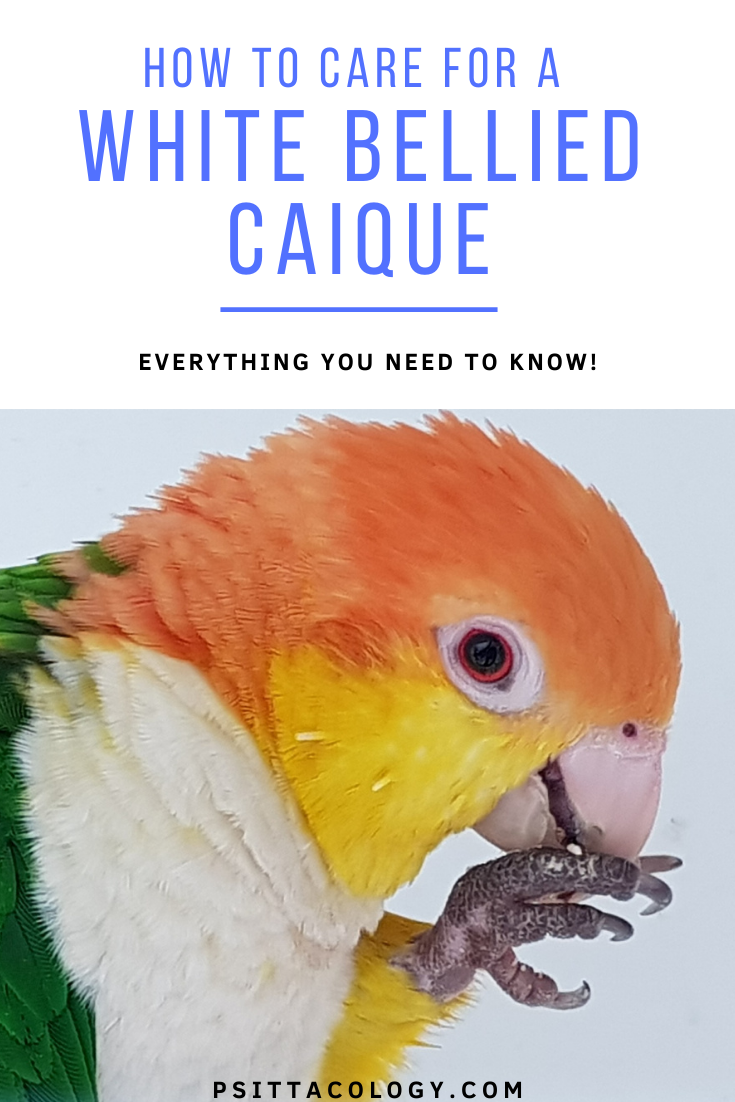
White-bellied caique diet
Wild diet
To find out more about what white-bellied caiques like to eat in the wild, let’s turn to science. A study by 2014 by Lee et al. took a peek at 190 white-bellied caiques in their wild habitat. They saw the birds feed on no less than 44 different plant species!
What exactly they ate varied through the seasons, but wild white-bellied caiques were most often seen feeding on seeds from all sorts of different plants, including fruit seeds. They also ate lots of fruits, many of them unripe.
Third in line were flowers and flower buds. Another study found that caiques also eat pollen and nectar; they’re actually important pollinators for some species of trees.
Apart from these food items, the wild caiques also occasionally consumed some miscellaneous foods like leaves and bark. They were even observed eating ants! Additionally, they visited clay licks to consume soil, probably to obtain important micronutrients.
Domestic diet
As we can gather from the above, white-bellied caiques naturally have a pretty varied diet. We can’t really replicate their natural diet, because few of us are going to have access to the seeds, fruits and flowers they eat.
So what should a domestic caique be eating? It’s important not to fall into the trap of feeding a seed mix and nothing else, even though that’s still the go-to for many inexperienced parrot owners. Seeds are too fatty and don’t contain the necessary (micro)nutrients to keep your caique going in the long run.
Feeding a very fruit-heavy diet is also not a good idea, even if it seems logical for fruit fiends like this species. The fruits they eat in the wild are much lower in sugars than the ones cultivated for human consumption. Additionally, they’re often eaten unripe, meaning even lower sugar levels.
Instead, consider a diet consisting of the following:
- A high-quality pellet food as a staple
- Plenty of fresh veggies
- Some fresh fruits
- (Sprouted) seed mix
- Cooked unsalted grains
- Foraged foods like select garden weeds
Very fatty or sugary foods, like nuts and dried fruits, are best used as (training) treats only.
Don’t forget to always have fresh water available as well, preferably from multiple sources. A calcium block is also important.
Tip: Want to learn more about what your caique or other parrot should be eating? Don’t forget to also check out the full guide to parrot diet.

White-bellied caique temperament
Their temperament is definitely what sets caiques apart from other parrot species. All parrots are intelligent and playful, but caiques take the cake! They’re known as the clowns of the parrot world. This is a title they deserve, but it’s not all there is to them.
A caique is a parrot you can bond very strongly with. However, once these birds pass through puberty, they can also become difficult. Like other parrots, they tend to bond to one person, and they can be prone to attacking even their “loved one”. You need to be ready and aware of how to deal with this.
A well-socialized caique will generally adore being able to hang out with you as much as possible. This does mean you need to be able to spend a lot of time with your bird; otherwise, you might want to consider getting two.
Did you know? Caiques are territorial. You can’t combine them with other bird species, as there is a real possibility of an attack taking place over a cage or food dispute.
Keep in mind that you do need a lot of patience to be able to deal with these birds. They just love throwing stuff around, have seemingly unlimited energy for dancing, playing and screaming, and they can even get cranky and nippy at times.
Proper training is important to help avoid unwanted behaviors! Even then, it’s a matter of when, not if, your caique will break something. Whether it be by chewing it up or throwing it on the floor, parrots in general tend to leave a trail of mayhem wherever they go.
All in all, don’t mind an extra dash of crazy in your parrot, a caique might be for you.
Tip: You can check out other caique owners’ content to see what life with a caique is like. Jalapeño Pancake’s Instagram is a good example of the shenanigans this species likes to get up to.
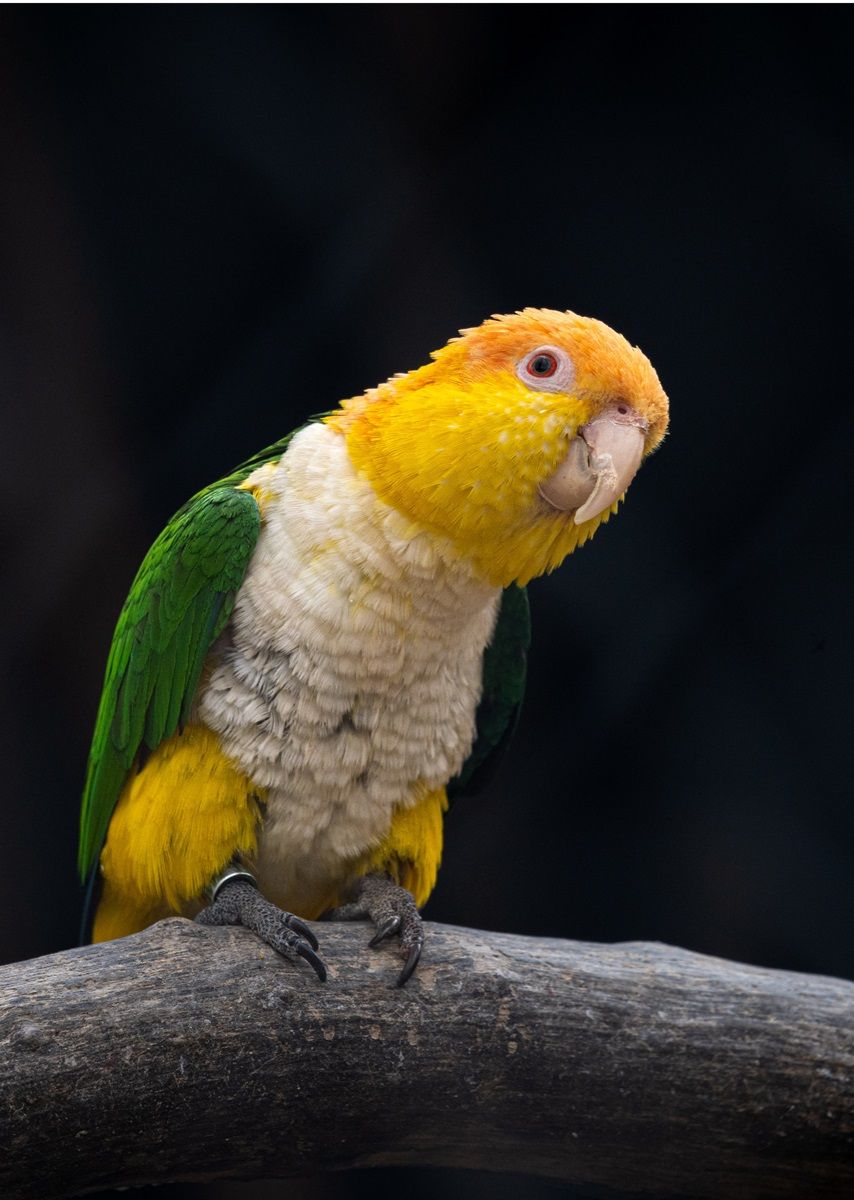
White-bellied caique housing
Because caiques are bombs of pure energy, it’s not surprising they need quite a bit of space. Even if your caique gets plenty of out-of-cage time, it’s still important to provide a large enclosure to keep your bird happy.
Your caique’s cage should be sturdy and preferably have some kind of locking mechanism, as these birds are very smart and might find it pretty easy to figure out how to escape. They also like to chew on cage bars. In fact, they like to chew on everything, so provide loads of toys!
Aside from toys, your caique’s cage should contain multiple natural perches, food and water bowls, and ideally also a bird bath.
Because your caique needs multiple hours of out-of-cage time each day, it’s handy to set up a little playground outside of the cage. The playground can be made of natural wood to encourage chewing and should contain plenty of toys to help keep your bird busy.
Tip: Any room your caique has access to should be fully parrot-proofed. They’re very curious and can get you and themselves in a lot of trouble with their exploring and destroying. And don’t forget to forego any scented products or items that can emit fumes near your bird!
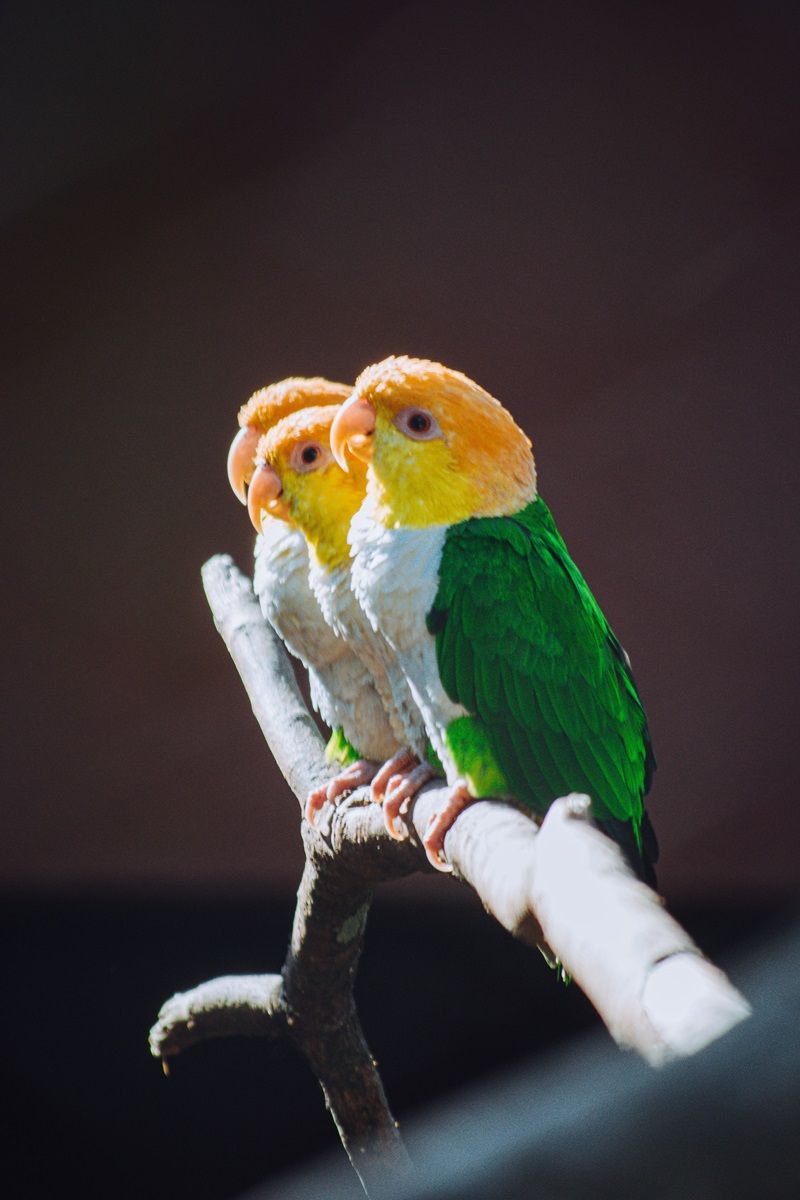
White-bellied caique enrichment
All parrots need plenty of enrichment to prevent boredom and loneliness, which can lead to serious issues like feather plucking, incessant screaming, and aggression. In the wild, they spend all day foraging and engaging their smart brains in the presence of a tight flock. Caiques are no exception to this.
Some important ways to offer enrichment to your caique on a daily basis include:
- Training. A double-edged sword! You can encourage positive behaviors and discourage unwanted ones while simultaneously engaging your bird’s brain. On top of that, these intelligent parrots easily pick up fun tricks.
- Hanging out. So important! Take your caique out of its cage for playtime and cuddles. These guys are extremely playful and might like to swing from your hand, wrestle while lying on their backs, crawl up your sleeves, and much more.
- Offer different toys. Your caique should have access to different parrot toys, preferably on a rotating basis. Get toys for chewing (including fresh bird-safe branches), ones that make noise, shredding toys, and more. You can easily DIY some of these.
- Foraging. What’s the one thing a parrot spends the most time doing in the wild? That’s right, looking for food. Replicate this brain-engaging activity in the home with foraging boxes, foraging toys and all sorts of DIY foraging options.

White-bellied caique sounds
As far as parrots go, caiques are not the loudest species out there. Does that mean they’re quiet? Well, no, there’s really no such thing as a quiet parrot. They all have the ability to get pretty raucous.
Although caiques tend to stick to whistling, beeping and soft squawking at a relatively acceptable noise level for most of the day, they can emit very shrill screams as well. Not surprising: in the wild they need to be able to locate each other from different tree tops.
All in all, as far as apartment living goes, caiques are a better choice than many other parrots. Still, remember that your days of enjoying silence without earplugs are bound to be over when you add any parrot to the family!
Do caiques talk?
If you’re looking for a talented talker, a caique is not the best choice for you. Although some individuals are better at it than others, caiques can’t compete with the champion talking parrot species.
This being said, caiques are still great candidates for vocalization training. Their talking skills might be limited, but they still do quite well when it comes to picking up whistles or tunes.
To teach your caique a tune, choose something short, like a wolf whistle. Then, just start repeating this throughout the day! If you notice the bird (trying to) repeat your chosen sound, be sure to reward with a treat. This is a great way to spend time with your bird while adding a fun trick to its vocabulary at the same time.

White-bellied caique medical emergencies
Although it’s not something we want to think about, it’s important to keep in mind that medical emergencies are a possibility with any pet. Especially an overly curious one like a parrot!
Before even considering going out and adding a caique to your family, you should know what to do if any sort of health crisis pops up. You should have the number for an avian vet in your area saved in your phone and be able to recognize common symptoms of illness.
Caiques are susceptible to polyomavirus, which causes severe organ issues, especially in young birds. Vaccinating your bird against this disease is recommendable. Ask your vet!
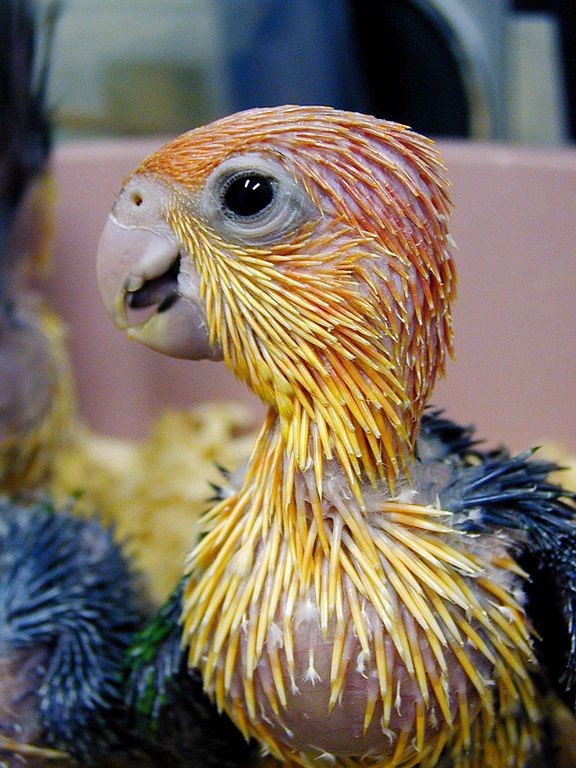
Ruth Rogers, CC BY 2.0, via Wikimedia Commons
Frequently asked questions
If you’d like to add a caique to your family, you have to be ready to commit for decades to come. They can live for over 40 years!
No, I would definitely not recommend caiques for beginning parrot keepers.
They can be. Caiques need a lot of careful socialization to keep them in check, Even then, some caique owners describe them as appearing “possessed by demons” during the mating season, and sometimes seemingly just for no reason.
If you have any more questions about white-bellied caiques or want to share your own experiences with these clowns of the parrot world, don’t hesitate to leave a comment below!
Sources & further reading
- Gilardi, J. D., & Munn, C. A. (1998). Patterns of activity, flocking, and habitat use in parrots of the Peruvian Amazon. The Condor, 100(4), 641-653.
- Lee, A. T., Brightsmith, D. J., Vargas, M. P., Leon, K. Q., Mejia, A. J., & Marsden, S. J. (2014). Diet and geophagy across a western Amazonian parrot assemblage. Biotropica, 46(3), 322-330.
- Maués, M. M., & Venturieri, G. C. (1996, June). Pollination ecology of Platonia insignis Mart.(Clusiaceae), a fruit tree from eastern Amazon region. In VII International Symposium on Pollination 437 (pp. 255-260).
- Parr, M., & Juniper, T. (2010). Parrots: a guide to parrots of the world. Bloomsbury Publishing.


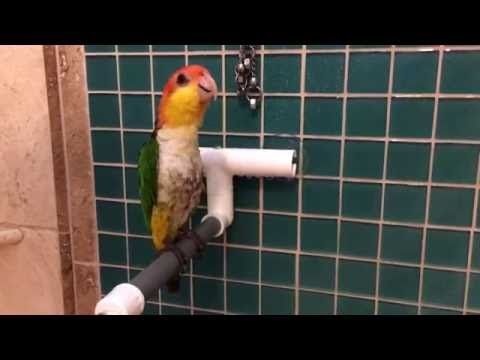
My Caique is 9 years old. We have always used a diet of fruits vegetables nuts and pellets. We also have a 5.0 UVB light for her cage. About 6 months ago some of her back feathers which were always a vibrant green began to turn yellow and her black feathers near the tail began to turn white. I have changes bulbs 3 x’s thinking that the UVB may be the issue. Although the discoloration hasn’t gotten worse it has not gotten much better. Do you have any suggestions?
I’ve replied to your email! 🙂
I have a male caique, he is 3 years old. He has become more aggressive with me, biting. Also about four weeks ago. He had what i thought may have had seizures, not sure. I have a video of it. I have brought him to vet twice now and still have no answers. He now seems scared of everything. He freaks out and bites leg. He is not as active anymore. I am at a loss. Any ideas or suggestions?
Hi! Sorry you’re having trouble with your caique. Which tests did the vet run? It does sound like it’s possible your bird is lashing out due to pain. Another possibility would be hormones – do you follow the guidelines to reduce hormonal behavior, ie. 12+ hours of sleep, no nesting sites, no inappropriate petting/allowing sexual behavior like regurgitation towards you? Lastly, caiques are known to turn into quasi-bipolar little devils once they reach a certain age.
Have you tried checking out other people’s experiences? Here are some threads I found online:
– Aggressive Caique Behavior
– Caiques and their Hormones. Completely different bird 4 years later?
– Help with my aggressive caique
Best of luck to you. Sorry I can’t give you a clearer answer.
Hi there, I have a black headed Caique, he is two years old and some feathers on his back has turned yellow. He was only 11 weeks old when I had him and he was missing his back claws on both feet. The breeder told me he had bubble foot coming out of the egg. He gets around fine and seems healthy could the change in feathers be a breeding mode thing?
Hello! Sorry about the late reply.
I know caiques change color as they mature, with their bellies turning from yellow to white at around a year of age. I don’t think I’ve heard of the feathers on their back changing, though, especially since your bird should already have its mature plumage. Parrot plumage changing color can be an indication there’s a problem related to diet or other factors, so I would take the bird to the vet just in case. Hope it turns out to be nothing!